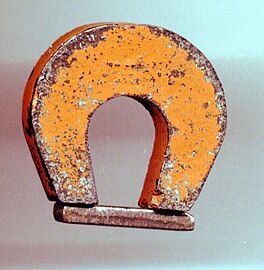| Articles about |
| Electromagnetism |
|---|
 |


A horseshoe magnet is either a permanent magnet or an electromagnet made in the shape of a horseshoe (in other words, in a U-shape). The permanent kind has become the most widely recognized symbol for magnets. [1]: 2 It is usually depicted as red and marked with 'North' and 'South' poles. [1]: 3 Although rendered obsolete in the 1950s by squat, cylindrical magnets made of modern materials, [1]: 3,467 horseshoe magnets are still regularly shown in elementary school textbooks. [1]: 3 Historically, they were a solution to the problem of making a compact magnet that does not destroy itself in its own demagnetizing field. [1]: 2 [2]
History
In 1819, it was discovered that passing electric current through a piece of metal deflected a compass needle. Following this discovery, many other experiments surrounding magnetism were attempted. These experiments culminated in William Sturgeon wrapping wire around a horseshoe-shaped piece of iron and running electric current through the wires creating the first horseshoe magnet. [3]
This was also the first practical electromagnet and the first magnet that could lift more mass than the magnet itself when the seven-ounce magnet was able to lift nine pounds of iron. [3] [4] Sturgeon showed that he could regulate the magnetic field of his horseshoe magnet by increasing or decreasing the amount of current being run through the wires. [4] This would lay the groundwork for development of the electrical telegraph and the future of world-wide telecommunications for the next century and more. [4]
Shape
The shape of the magnet was originally created as a replacement for the bar magnet as it makes the magnet stronger. [5] A horseshoe magnet is stronger because both poles of the magnet are closer to each other and in the same plane which allows the magnetic lines of flux to flow along a more direct path between the poles and concentrates the magnetic field. [6]
The shape of the horseshoe magnet also drastically reduces its demagnetization over time. [7] This is due to coercivity also known as the "staying magnetized" ability of a given magnet. [7] Coercivity is weaker in disc or ring shapes, slightly stronger in cylinder or bar shapes, and strongest in horseshoe shapes. [6] [7] To increase the coercivity of horseshoe magnets, steel keepers or magnet keepers are used. [7] A magnetic field holds its strength best when the entire magnetic field is given the ability to loop through a ferromagnetic substance instead of air. [8] The nearness of the horseshoe magnet’s poles facilitates the ability to use these magnet keepers more easily than other types of magnets. [8]
-
A horseshoe magnet made of AlNiCo, an iron alloy. The attached iron bar is a magnet keeper used to prevent demagnetization.
-
Magnetic field of a horseshoe magnet. The field is greatest where the lines are densest, around the poles (lower)
-
Alnico horseshoe magnet used in a magnetron tube in an early microwave oven. About 3 in (8 cm) long.
-
Assortment of AlNiCo horseshoe magnet shapes available from a manufacturer in 1956.
-
A rectangular horseshoe magnet.
References
- ^ a b c d e Coey, J. M. D. (2010). Magnetism and Magnetic Materials. Cambridge University Press. ISBN 978-0-511-67743-4.
- ^ "Why are Magnets Shaped like Horseshoes?". K&J Magnetics, Inc. Archived from the original on 24 December 2022. Retrieved 23 February 2023.
- ^ a b "Magnetism and Electromagnetism". Spark Museum. SPARK Museum of Electrical Invention. Retrieved 3 January 2021.
- ^ a b c Bellis, Mary (23 February 2019). "William Sturgeon and the Invention of the Electromagnet". ThoughtCo. Retrieved 3 January 2021.
- ^ "The Various Shapes of Magnets and Their Uses". Apex Magnets. Retrieved 3 January 2021.
- ^ a b "Temperature and Neodymium Magnets". K&J Magnetics. K&J Magnetics, Inc. Retrieved 3 January 2021.
- ^ a b c d "Why are Magnets Shaped like Horseshoes?". K&J Magnetics. K&J Magnetics, Inc. Retrieved 3 January 2021.
- ^ a b "Demagnetizing a Steel Nail". Sciencing. Retrieved 3 January 2021.
External links
-
 Media related to
Horseshoe magnets at Wikimedia Commons
Media related to
Horseshoe magnets at Wikimedia Commons




